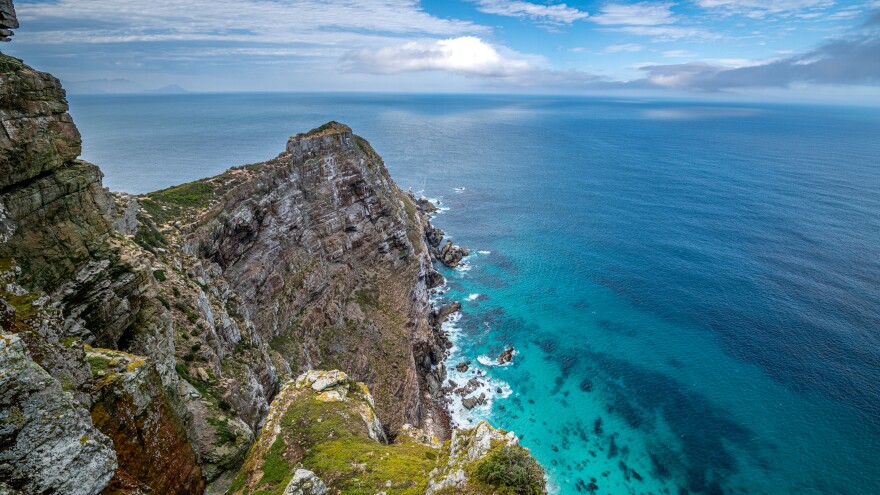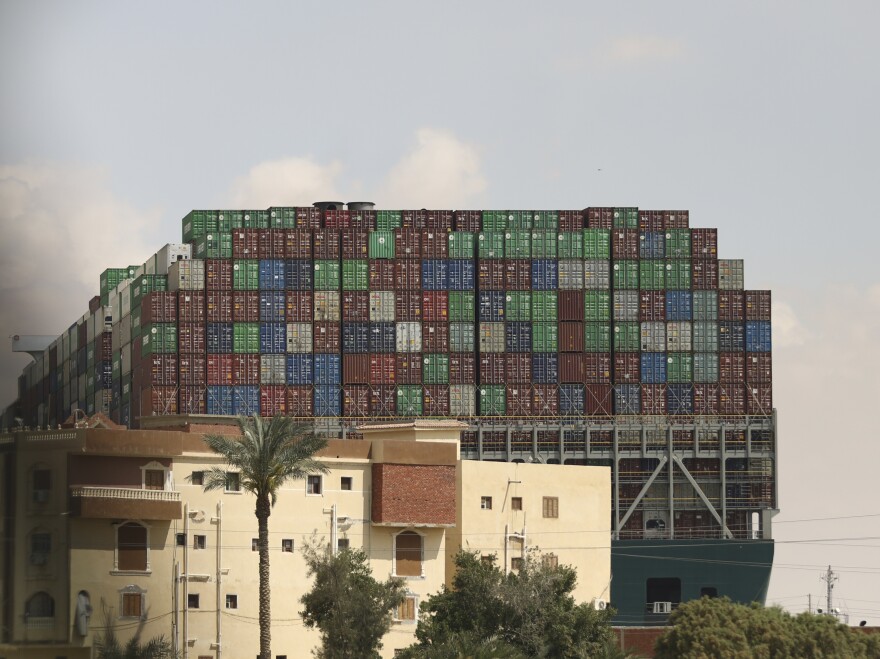Updated March 29, 2021 at 11:09 AM ET
Before the grounding of the massive Ever Given container ship in the Suez Canal, some 50 vessels a day, or about 10% of global trade, sailed through the waterway each day — everything from consumer electronics to food, chemicals, ore and petroleum.
When the ship was lodged sideways in the canal, closing off the main oceangoing highway between Europe and Asia, much of that cargo sat idle, either waiting to transit or stuck in port while owners and shippers tried to decide what to do. It was a waiting game that Lloyd's List estimated cost $9.6 billion per day.
That traffic will begin flowing again, now that the vessel has finally been freed.
NPR took a look at the implications for the shipping industry and for global trade.
What were the alternatives to ships while the Suez Canal was closed?
Ship owners and operators had a few options, but none were particularly good ones.
The adage that time is money couldn't be more true in the shipping business. For vessels already backed up in the canal, if the waterway had remained blocked, a decision would have been needed to be made about whether to continue waiting or go to Plan B.
"For vessels already up the Suez, it will take several days just to sail south on the Red Sea and get on a shipping lane around Africa," Basil Karatzas, CEO of Karatzas Marine Advisors & Co., a New York-based shipping finance advisory and ship brokerage, said Friday. From there, "round Africa" — the only practical seagoing route between Europe and Asia for centuries before the Suez was opened in 1869 — would take weeks more.
"If they start sailing (prematurely) around Africa, they are guaranteed a two- to four-week delay and several million [dollars] extra costs in fuel," Karatzas said. Instead, owners and operators of many vessels stuck at the canal were simply waiting and hoping "for a quick resolution."
To get an idea just what a shortcut the canal represents, commodity analysts Kpler said that for a vessel averaging 12 knots (14 mph), Suez to Amsterdam, takes 13 days via the canal. Around the Cape of Good Hope, it takes 41 days.
The reopening of the canal spares shippers some tough and potentially costly decisions. The same goes for vessels that haven't yet left port, although the cost in time and money for them wouldn't have been as great.

Another possible option would have been to go through the Panama Canal by way of the Pacific. But many of the largest commercial vessels today, such as the 1,300-foot Ever Given herself, are too big to fit through the Panama Canal.
Jonathan Roach, a container market analyst for Braemar ACM Shipbroking, said in a recent letter to clients that if the situation at the canal was not resolved soon, the route via the Cape of Good Hope was the most likely detour, even for vessels that can fit through the Panama Canal.
Last year, due to a combination of excess capacity and falling fuel prices, some shippers did just that — opting to go the Africa route to avoid Suez Canal transit fees.
Theoretically, there was one more possibility, but it too has severe limitations. A shorter route through the Arctic known alternately as the Northeast Passage, or the Northern Sea Route, or NSR, has been touted by Russia.
The number of vessels using the NSR has increased to several hundred each year, thanks in part to global warming that has reduced polar ice. However, traffic there still amounts to a mere fraction of what passes through the Suez.
The Northern Sea Route is still not considered practical by most shipping companies. For example, in 2018, Maersk, the world's largest container line, sent one of its ships via the NSR, but the company emphasized it doesn't see the route "as an alternative to our usual routes" and that the voyage was merely "a trial to explore an unknown route for container shipping and to collect scientific data."
Lastly, it's worth noting that a prolonged shutdown of the Suez Canal is not unprecedented. The waterway was closed for eight years, beginning in 1967, after war broke out between Egypt and Israel. As a result, ships were forced to divert around the tip of Africa.
As of Friday, Kpler told NPR that two Europe-bound liquefied natural gas carriers had diverted and that several more ships carrying gasoline and diesel appeared to have also done so.
How would a prolonged shutdown of the Suez have affected the supply chain?
Global supply chains, already significantly disrupted by the coronavirus pandemic, could have been further stressed by a prolonged shutdown of the Suez Canal, said Jonathan Gold, vice president for supply chain and customs policy with the National Retail Federation.
"This is just one more challenge to the supply chain operations that we're seeing across the board," Gold said Friday. "[We are] already seeing congestion and other things impacting the supply chain. This is one more thing that adds to that."
The greatest impact would have been felt in the European market, which relies most on transfers through the canal. But given the interconnected nature of global manufacturing and commerce, there was likely to have been a knock-on effect for the United States.
"These things can't be looked at discretely," said Jennifer Bisceglie, an expert in global supply chain resilience and founder and CEO of Interos Inc. "Last year, you had this big wake-up call of the concentration risks of the physical supply chain from COVID, and then you had this on top of it."
Bisceglie said it's time for companies to consider "having more disparate [supply hubs] instead of having all our eggs on one cargo ship."
Maersk told NPR on Friday that it was too early to commit to rerouting any of its massive global container fleet. The Copenhagen, Denmark-based company said in a statement, that while "out of our control, we apologize for the inconvenience this incident may cause to your business and for critical shipments."
"[We] recommend that you reach out to your local sales representative for dialogues and quotations on alternative solutions, such as air and rail for urgent cargo that is still at origin or elsewhere," Maersk had said.

Would a long shutdown have meant a rise in prices?
As it turns out, a weeklong delay for a few hundred ships at the Suez will only have a negligible impact for consumers, but a prolonged delay could have increased the cost of shipping, complicated manufacturing and ultimately driven up prices.
"[A] few days might not have a meaningful impact," said John Kartsonas of Breakwave Advisors, which specializes in asset management and advisory services for the shipping and commodities industries. But if the situation had taken weeks to resolve, as had been feared earlier, the disruptions would likely have sent shipping rates higher.
Operating costs would have climbed significantly, too. More days at sea means burning more fuel.
"The large container ships, the super, mega-max container ships, can burn 100 [to] 150 tons of fuel a day," Braemar ACM Shipbroking's Roach told NPR.
That's $80,000 a day in fuel and an extra 10 days travel time — both to and from Asia. "So, you're looking at the best part of a million dollars with your operating costs. So it's a million dollars out and a million dollars back," he said.
In his letter to clients, Roach also noted problems at the Suez Canal could disrupt the flow of containers. A trade imbalance between Europe and Asia means that filled containers going west return mostly empty to ports in the east to be refilled. "If empty stocks dwindle in Asia, there is the short-term possibility of an increase" in prices, Roach wrote.
Insurance was another consideration.
Richard Meade, editor at Lloyd's List, said a prolonged blockage at the Suez would have had financial implications "borne by the owners, but then passed onto the insurers."
"And then that will obviously result in a spike in insurance premiums," he said on Friday.
Overall, though, Joanna Konings, a senior economist at ING, told Bloomberg that she was "relatively sanguine" about the impact on trade. But she wouldn't rule out "an inflationary shock that could come right to the consumer."

Would gas prices have gone up?
Shipping rates for petroleum products nearly doubled in the aftermath of the Ever Given's grounding, according to Reuters. But now that the situation is resolved, they are likely to stabilize.
Although oil prices may also have felt some upward pressure in the wake of the Ever Given incident, their increase was blunted by news of further COVID-19 lockdowns in Europe that are likely to continue to depress demand.
What would it have meant at the pump?
"If the Suez Canal remains blocked for more than a few more days or over a week, we could likely see some disruptions in oil flows between the Middle East and Europe that could impact price globally," Patrick De Haan, the head of petroleum analysis at GasBuddy, said Friday, days before the ship was freed.
"But it should not hamper flows of oil to North America," De Haan said. "At worst, if the issue continues, if oil prices do see a sustained rally, the blockage could have a small and limited impact on gas prices, likely no more than a few cents per gallon on average."
Copyright 2021 NPR. To see more, visit https://www.npr.org.



